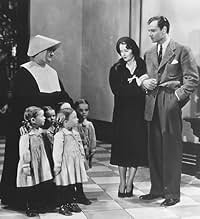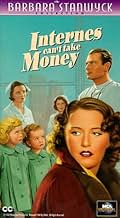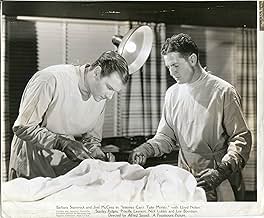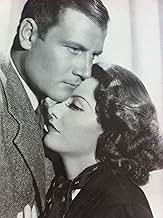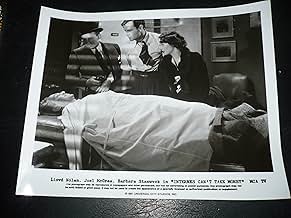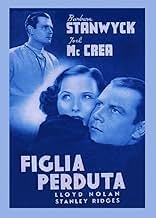- Awards
- 1 win total
Steve Pendleton
- Interne Jones
- (as Gaylord Pendleton)
James Adamson
- Porter
- (uncredited)
Agostino Borgato
- Popcorn Vendor
- (uncredited)
Helen Brown
- Nurse
- (uncredited)
- Director
- Writers
- All cast & crew
- Production, box office & more at IMDbPro
Featured reviews
An exceptionally flavorful rendering of the Depression atmosphere: a world of the poor laboring in sweatshop jobs, petty hoods hanging out in smoky bars, backroom bookie joints, pushcart vendors and bus terminals and orphanages. While the plot is no more ambitious than the typical B movie of the time, the high production values, name cast, and imaginative direction from Alfred Santell all boost the quality.
At the center of the plot, Barbara Stanwyck spends much of the film in desperation mode, exhausted from searching for her lost child, beaten down by two years in jail, forced to hire stool pigeons, forced to stay alert.
Joel McCrea makes the ideal American hero for the 30's: not only a doctor, but tall, blond, honest, sincere, manly, and progressive. At one point, he has to perform an operation on a bar room table, improvising with violin strings, an ice pick, and a bottle of rum! But this is not MGM's Dr. Kildare. He has no warm relationship with a kindly old mentor; instead, the chief doctor is an authority figure upholding the rules, dismissing Lee Bowman for unauthorized experimentation. The script also pumps up sympathy for interns as underpaid workers who get only $10 a month.
As a gangster, the always fascinating Stanley Ridges conveys the calm of a man secure in his power, whose eye movements size up his adversaries and whose silences reveal more menace than mere words. Watch the sexual innuendo he finds in his "I didn't always like popcorn" speech.
Santell uses extreme close-ups and moves the camera often, aided by gleaming lighting from Theodore Sparkuhl, plus some knock-out sets, including a sparkling white Art Deco clinic and an elaborately detailed New York Irish bar. Watch how economically Santell works to show the awakening of mutual attraction between Stanwyck and McCrea in their first scene together. Also lifting the picture out of its formula origins is the headlong pace Santell maintains to the climax, an urgency lost in the blander MGM series.
At the center of the plot, Barbara Stanwyck spends much of the film in desperation mode, exhausted from searching for her lost child, beaten down by two years in jail, forced to hire stool pigeons, forced to stay alert.
Joel McCrea makes the ideal American hero for the 30's: not only a doctor, but tall, blond, honest, sincere, manly, and progressive. At one point, he has to perform an operation on a bar room table, improvising with violin strings, an ice pick, and a bottle of rum! But this is not MGM's Dr. Kildare. He has no warm relationship with a kindly old mentor; instead, the chief doctor is an authority figure upholding the rules, dismissing Lee Bowman for unauthorized experimentation. The script also pumps up sympathy for interns as underpaid workers who get only $10 a month.
As a gangster, the always fascinating Stanley Ridges conveys the calm of a man secure in his power, whose eye movements size up his adversaries and whose silences reveal more menace than mere words. Watch the sexual innuendo he finds in his "I didn't always like popcorn" speech.
Santell uses extreme close-ups and moves the camera often, aided by gleaming lighting from Theodore Sparkuhl, plus some knock-out sets, including a sparkling white Art Deco clinic and an elaborately detailed New York Irish bar. Watch how economically Santell works to show the awakening of mutual attraction between Stanwyck and McCrea in their first scene together. Also lifting the picture out of its formula origins is the headlong pace Santell maintains to the climax, an urgency lost in the blander MGM series.
A wildly improbable drama, the misspelled "Internes Can't Take Money" was the first in the "Dr.Kildare" movie series, which was subsequently recast with Lew Ayres in the title role and continued at the MGM studio, following this initial Paramount effort. Concocted by writer Max Brand, the story involves an honest young intern at a large hospital, who crosses paths with a widowed ex-con seeking to locate her three-year-old daughter, who was abducted by her deceased bank-robber husband. The recipe is an old one; toss in a couple of shady characters and a gangster with a heart of gold, who is embroiled in illegal betting, add a tolerant landlady and a kindly bartender, sprinkle with nuns, mix with unexpected twists, and bake until overdone.
Despite an uninspired title and a routine script, director Alfred Santell maintains a steady pace that will distract viewers from the at-times laughable plot turns that lead to a teary fade-out, provoked either by laughter or sentiment. Beyond the script, the film's technical aspects are quite good, especially the black and white cinematography by Theodor Sparkuhl, who often dramatically captures Stanwyck garbed in deep black, contrasting with McCrea, dressed in his intern's whites.
Barbara Stanwyck plays the widow, Janet Haley, and the actress, at her sudsy distraught-mother best, is convincing in an unconvincing role. Joel McCrea is the original Dr. Kildare, a straight-arrow intern, poorly paid and burdened by work and rules, who seeks solace at a nearby bar, where his life takes a sudden turn. Stanwyck and McCrea, in their third co-starring film, work well together, and Stanwyck seems genuinely taken with McCrea during their first scene together. Attesting to what makes a film star a star, Stanwyck and McCrea add dimension and interest to otherwise cardboard characters in credibility-stretching situations. In addition to the two stars, the capable cast also includes Lloyd Nolan, Stanley Ridges, and Charles Lane. However, if not for the professionalism and charisma of the leads and supporting players, "Internes Can't Take Money" would be 80 minutes of laughable coincidences and plot turns, memorable only as the first in the Dr. Kildare movie series.
Despite an uninspired title and a routine script, director Alfred Santell maintains a steady pace that will distract viewers from the at-times laughable plot turns that lead to a teary fade-out, provoked either by laughter or sentiment. Beyond the script, the film's technical aspects are quite good, especially the black and white cinematography by Theodor Sparkuhl, who often dramatically captures Stanwyck garbed in deep black, contrasting with McCrea, dressed in his intern's whites.
Barbara Stanwyck plays the widow, Janet Haley, and the actress, at her sudsy distraught-mother best, is convincing in an unconvincing role. Joel McCrea is the original Dr. Kildare, a straight-arrow intern, poorly paid and burdened by work and rules, who seeks solace at a nearby bar, where his life takes a sudden turn. Stanwyck and McCrea, in their third co-starring film, work well together, and Stanwyck seems genuinely taken with McCrea during their first scene together. Attesting to what makes a film star a star, Stanwyck and McCrea add dimension and interest to otherwise cardboard characters in credibility-stretching situations. In addition to the two stars, the capable cast also includes Lloyd Nolan, Stanley Ridges, and Charles Lane. However, if not for the professionalism and charisma of the leads and supporting players, "Internes Can't Take Money" would be 80 minutes of laughable coincidences and plot turns, memorable only as the first in the Dr. Kildare movie series.
Probably not, but it has a certain cachet to it that is reminiscent of the genre that was yet to come. Good folk and gangsters, an unsuspecting someone caught in a web of dishonesty and murder, and all with the shadows and photographic effects normally associated with film noir. It is also an early Dr. Kildare film with Joel McCrea as the good doctor.
Nutshell: Kildare comes across Barbara Stanwyck, who is destitute and desperate. She is looking for her lost child and she is broke and just released from prison, apparently framed for aiding and abetting her husband. Kildare tries to help, with the aid of a gangster (Lloyd Nolan) on whom he has done emergency surgery (in the back of a barroom!) and who now feels he owes Kildare a favor.
The cast is excellent, headed by Stanwyck who never gives a bad performance. McCrea is his usual understated self and Stanley Ridges is very effective as a seedy, slimy villain. This is a very underrated film and was shown at Capitolfest, Rome, NY, 8/19.
******** 8/10 - Website no longer prints my star rating.
Nutshell: Kildare comes across Barbara Stanwyck, who is destitute and desperate. She is looking for her lost child and she is broke and just released from prison, apparently framed for aiding and abetting her husband. Kildare tries to help, with the aid of a gangster (Lloyd Nolan) on whom he has done emergency surgery (in the back of a barroom!) and who now feels he owes Kildare a favor.
The cast is excellent, headed by Stanwyck who never gives a bad performance. McCrea is his usual understated self and Stanley Ridges is very effective as a seedy, slimy villain. This is a very underrated film and was shown at Capitolfest, Rome, NY, 8/19.
******** 8/10 - Website no longer prints my star rating.
... except this one is from Paramount and stars Joel McCrea as Dr. James Kildare. Like in the MGM series starting the following year, Dr. Kildare is an intern in a large New York City hospital, he lives on subsistence wages, and has a pretty grueling schedule. Unlike the MGM series there is no hot tempered wheelchair bound mentor in the person of one Dr. Gillespie. In all of his judgements here, Kildare is pretty much on his own.
As an intern in the hospital, Kildare treats a young woman for a burn on her hand (Barbara Stanwyck as Janet Haley). She also turns out to be undernourished so Kildare makes her lie down and drink a glass of milk. He then discharges her. It turns out Janet does have a job, she's just been cutting corners including her own meals to save money to pay for stool pigeons to help her find her own three year old child. She had been stolen by her estranged husband to keep her quiet about his illegal activities, but he died after pulling a hold up before he could tell her where the child was. She spent two years in prison because everybody believed she was in on the robbery with her husband.
If this is starting to sound like it is mainly about Stanwyck's character and not so much about Kildare, you would be right. This is mainly Stanwyck's film. But Kildare does figure heavily into helping Janet solve her dilemma. Also figuring heavily into the plot is Kildare's big taste for risk if it helps somebody out. That includes sewing up a gangster (Lloyd Nolan) after he shows up at a cafe and bar near the hospital, stabbed in some underworld activity and requiring immediate medical attention.
I think I prefer Lew Ayres' interpretation of the role, but this film is still worthwhile.
As an intern in the hospital, Kildare treats a young woman for a burn on her hand (Barbara Stanwyck as Janet Haley). She also turns out to be undernourished so Kildare makes her lie down and drink a glass of milk. He then discharges her. It turns out Janet does have a job, she's just been cutting corners including her own meals to save money to pay for stool pigeons to help her find her own three year old child. She had been stolen by her estranged husband to keep her quiet about his illegal activities, but he died after pulling a hold up before he could tell her where the child was. She spent two years in prison because everybody believed she was in on the robbery with her husband.
If this is starting to sound like it is mainly about Stanwyck's character and not so much about Kildare, you would be right. This is mainly Stanwyck's film. But Kildare does figure heavily into helping Janet solve her dilemma. Also figuring heavily into the plot is Kildare's big taste for risk if it helps somebody out. That includes sewing up a gangster (Lloyd Nolan) after he shows up at a cafe and bar near the hospital, stabbed in some underworld activity and requiring immediate medical attention.
I think I prefer Lew Ayres' interpretation of the role, but this film is still worthwhile.
I wonder when they dropped the "e" from interns. Interesting.
Internes Can't Take Money stars Joel McCrea, Barbara Stanwyck, Lee Bowman, Lloyd Nolan, and Stanley Ridges.
Dr. K. falls hard for one of his patients, Janet (Stanwyck) but she is a very troubled woman. She was sent to prison for two years as she was believed to be part of a robbery, led by her husband. When he was released, he took their daughter. She is now desperate to find her child, and will stoop to just about anything, even stealing from Kildare and taking up with gangster Stanley Ridges.
When Kildare finds out her real story, he tries to help her. He saved the life of another criminal (Nolan), actually in the local bar, and calls upon him for a favor.
Joel McCrea is an adorable Kildare - so handsome, and there was always something guileless about the actor. He plays very well with Stanwyck - in fact, they made six films together.
Of interest, interns in this film made a whopping $10 a month ($180 today) and one woman mentioned she made $27.50 a week ($495.00). When Kildare operates outside of the hospital, he's given $1000, but he gives it back because - you got it - "interns can't take money."
I do love Lew Ayres as Kildare, but McCrea's more aggressive interpretation worked well.
Internes Can't Take Money stars Joel McCrea, Barbara Stanwyck, Lee Bowman, Lloyd Nolan, and Stanley Ridges.
Dr. K. falls hard for one of his patients, Janet (Stanwyck) but she is a very troubled woman. She was sent to prison for two years as she was believed to be part of a robbery, led by her husband. When he was released, he took their daughter. She is now desperate to find her child, and will stoop to just about anything, even stealing from Kildare and taking up with gangster Stanley Ridges.
When Kildare finds out her real story, he tries to help her. He saved the life of another criminal (Nolan), actually in the local bar, and calls upon him for a favor.
Joel McCrea is an adorable Kildare - so handsome, and there was always something guileless about the actor. He plays very well with Stanwyck - in fact, they made six films together.
Of interest, interns in this film made a whopping $10 a month ($180 today) and one woman mentioned she made $27.50 a week ($495.00). When Kildare operates outside of the hospital, he's given $1000, but he gives it back because - you got it - "interns can't take money."
I do love Lew Ayres as Kildare, but McCrea's more aggressive interpretation worked well.
Did you know
- TriviaBarbara Stanwyck asked director Al Santell to cast Joel McCrea as her leading man, having worked with him twice before. "I want this guy," she told him. "He's going to be a good leading man."
- GoofsDuring the bar-room conversation (c.16 minutes) the coffee cup on the table disappears, re-appears and moves between shots.
- Quotes
Bookie: Maybe it's the cops.
"Chief" Hanlon: Cops don't knock, they break in.
- ConnectionsFollowed by Le Jeune Docteur Kildare (1938)
- How long is Internes Can't Take Money?Powered by Alexa
Details
- Release date
- Country of origin
- Language
- Also known as
- Internes Can't Take Money
- Filming locations
- Manhattan, New York City, New York, USA(Second unit opening credits)
- Production company
- See more company credits at IMDbPro
- Runtime
- 1h 18m(78 min)
- Color
- Aspect ratio
- 1.37 : 1
Contribute to this page
Suggest an edit or add missing content

